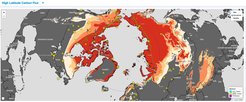Arctic methane emissions estimated by atmospheric inverse modeling
Lead: Luana Basso
Arctic methane emissions estimated by atmospheric inverse modeling
Identifying, understanding and quantifying methane sources at global to regional scales is essential to reduce uncertainties in the global methane budget and its feedbacks with the climate system. In this regard, some regions such as the Arctic permafrost landscapes are of great importance: With temperatures rising at rates at least twice the global average over the last decades, Arctic permafrost is increasingly thawing. Associated disturbance processes hold the potential to increase methane emissions, resulting in positive feedback to climate change; however, since only few observational sites with short time series are currently available (High Latitude Carbon Flux Sites), until now neither observations nor model estimates could provide clear evidence of such a trend in emissions. As a consequence, current and possible future contributions of Arctic ecosystems to the accelerated increase in the global atmospheric methane levels remain highly uncertain.

Atmospheric inverse modeling frameworks are important tools to estimate surface-atmosphere fluxes on a regional to global scales. The approach combines a-priori flux estimates and uncertainties of the source and sink flux magnitudes with the inverse mode of atmospheric transport to estimate model-calculated mixing ratio time series. These are subsequently compared to well-calibrated observations of atmospheric greenhouse gas mixing ratios, and flux magnitudes and the spatial distribution of sources and sinks are optimized to quantify large-scale a-posteriori emissions. With this approach, we can adjust both regional and global budgets, allowing us to investigate possible trends over time and climate and human-disturbance feedbacks.
In this project, our main focus is on estimating methane fluxes using the Jena CarboScope Global Inversion System for the Arctic region, assimilating atmospheric observations from all the different regional and local networks available. We will also be able to investigate changes and trends over time and climate feedbacks on methane emissions at higher northern latitudes. Once model upgrading and evaluation will be finished, in collaboration with colleagues at MPI-M the resulting framework will be used to evaluate and improve a new version of the biogeochemical process model JSBACH for simulating CH4 emissions from Arctic permafrost ecosystems.
